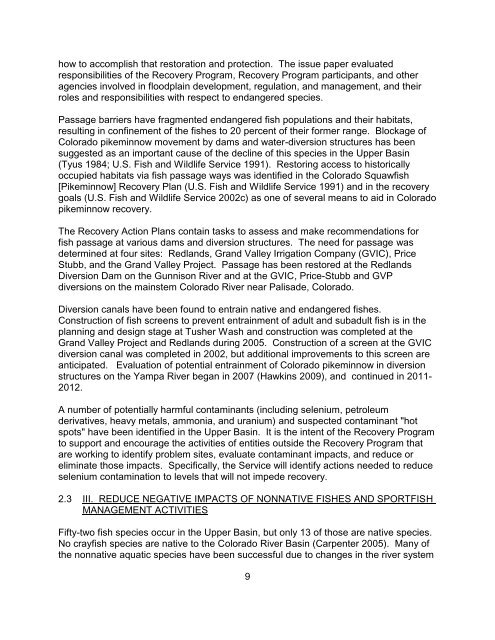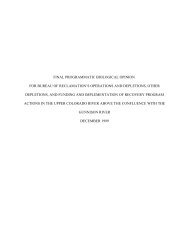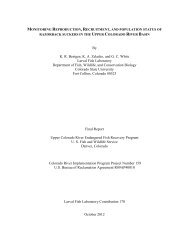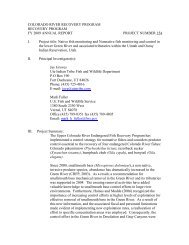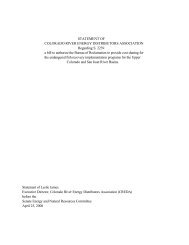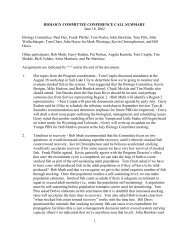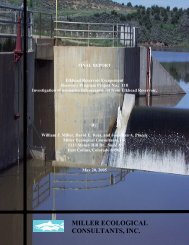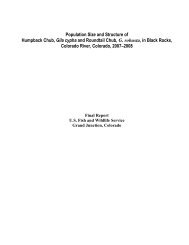Historically, <strong>Upper</strong> <strong>Colorado</strong> <strong>River</strong> Basin floodplains were frequently inundated byspring runoff, but today much of the river is channelized by levees, dikes, rip-rap, andtamarisk. <strong>Fish</strong> access to these flooded bottomlands has been further reduced bydecreased peak spring flows due to upstream impoundments. Numerous studies havesuggested the importance of seasonal flooding to river productivity, and floodedbottomlands have been shown to contain large numbers of zooplankton and benthicorganisms. Floodplain areas inundated and temporarily connected to the main channelby spring flows appear to be important habitats for all life stages of razorback sucker,and the seasonal timing of razorback sucker reproduction suggests an adaptation forutilizing these habitats. Restoring access to these warm and productive habitats wouldprovide the growth and conditioning environments that appear crucial for recovery ofself-sustaining razorback sucker populations. In addition, <strong>Colorado</strong> pikeminnow alsouse these areas for feeding prior to migrating to spawning areas. Inundation offloodplain habitats, although most important for razorback sucker, would benefit othernative fishes by providing growth and conditioning environments and by restoringecological processes dependent on periodic river-floodplain connections. Restorationof floodplain habitats could be achieved through a combination of increased peak flows,prolonged peak-flow duration, lower bank or levee heights, and constructed inlets.Studies have shown that full utilization of these floodplain habitats has been hamperedby the presence of large numbers of predacious and competing nonnative fish. Studiesare underway to determine how this interaction may be reduced to enhance use ofthese habitats by endangered fish. For example, additional evaluation of the floodplainreset theory will be needed to determine if nonnative fish can be reduced or eliminatedduring low-flow years.The <strong>Recovery</strong> Action Plans contain tasks to identify and restore important floodedbottomland habitats. During 1994, the <strong>Recovery</strong> <strong>Program</strong> completed an inventory offloodplain habitats for 870 miles of the <strong>Colorado</strong>, Green, Gunnison, Yampa, and Whiterivers. From the list of inventoried habitats, high-priority sites were screened forrestoration potential. Site acquisition began in 1994 and continued through 2003.Since 2003, the <strong>Program</strong> has completed the razorback sucker floodplain habitat modeland floodplain management plans for the Green and <strong>Colorado</strong> <strong>River</strong> sub-basins(subject to revision as new information is gathered). Based on the model and thesemanagement plans, the <strong>Program</strong> has shifted from screening additional floodplain sitesfor potential restoration/acquisition to focusing on sites already acquired or otherwiseavailable for management. Success will be measured by the response of theendangered fish populations.The General <strong>Recovery</strong> <strong>Program</strong> Support Action Plan contains tasks to develop an issuepaper on floodplain restoration and protection. This paper identified legal, institutional,and political strategies to enhance and protect floodplain habitats for the endangeredfishes and ameliorate the effects of levees, diking, rip-rap, gravel mining, and otherforms of floodplain development. Phase 1 of the issue paper identified what floodplainrestoration and protection is needed for the endangered fishes; Phase 2 determined8
how to accomplish that restoration and protection. The issue paper evaluatedresponsibilities of the <strong>Recovery</strong> <strong>Program</strong>, <strong>Recovery</strong> <strong>Program</strong> participants, and otheragencies involved in floodplain development, regulation, and management, and theirroles and responsibilities with respect to endangered species.Passage barriers have fragmented endangered fish populations and their habitats,resulting in confinement of the fishes to 20 percent of their former range. Blockage of<strong>Colorado</strong> pikeminnow movement by dams and water-diversion structures has beensuggested as an important cause of the decline of this species in the <strong>Upper</strong> Basin(Tyus 1984; U.S. <strong>Fish</strong> and Wildlife Service 1991). Restoring access to historicallyoccupied habitats via fish passage ways was identified in the <strong>Colorado</strong> Squawfish[Pikeminnow] <strong>Recovery</strong> Plan (U.S. <strong>Fish</strong> and Wildlife Service 1991) and in the recoverygoals (U.S. <strong>Fish</strong> and Wildlife Service 2002c) as one of several means to aid in <strong>Colorado</strong>pikeminnow recovery.The <strong>Recovery</strong> Action Plans contain tasks to assess and make recommendations forfish passage at various dams and diversion structures. The need for passage wasdetermined at four sites: Redlands, Grand Valley Irrigation Company (GVIC), PriceStubb, and the Grand Valley Project. Passage has been restored at the RedlandsDiversion Dam on the Gunnison <strong>River</strong> and at the GVIC, Price-Stubb and GVPdiversions on the mainstem <strong>Colorado</strong> <strong>River</strong> near Palisade, <strong>Colorado</strong>.Diversion canals have been found to entrain native and endangered fishes.Construction of fish screens to prevent entrainment of adult and subadult fish is in theplanning and design stage at Tusher Wash and construction was completed at theGrand Valley Project and Redlands during 2005. Construction of a screen at the GVICdiversion canal was completed in 2002, but additional improvements to this screen areanticipated. Evaluation of potential entrainment of <strong>Colorado</strong> pikeminnow in diversionstructures on the Yampa <strong>River</strong> began in 2007 (Hawkins 2009), and continued in 2011-2012.A number of potentially harmful contaminants (including selenium, petroleumderivatives, heavy metals, ammonia, and uranium) and suspected contaminant "hotspots" have been identified in the <strong>Upper</strong> Basin. It is the intent of the <strong>Recovery</strong> <strong>Program</strong>to support and encourage the activities of entities outside the <strong>Recovery</strong> <strong>Program</strong> thatare working to identify problem sites, evaluate contaminant impacts, and reduce oreliminate those impacts. Specifically, the Service will identify actions needed to reduceselenium contamination to levels that will not impede recovery.2.3 III. REDUCE NEGATIVE IMPACTS OF NONNATIVE FISHES AND SPORTFISHMANAGEMENT ACTIVITIESFifty-two fish species occur in the <strong>Upper</strong> Basin, but only 13 of those are native species.No crayfish species are native to the <strong>Colorado</strong> <strong>River</strong> Basin (Carpenter 2005). Many ofthe nonnative aquatic species have been successful due to changes in the river system9
- Page 1 and 2: RECOVERY IMPLEMENTATION PROGRAMSECT
- Page 3 and 4: PART ONE:RECOVERY IMPLEMENTATION PR
- Page 5 and 6: The Fish and Wildlife Service (FWS)
- Page 7 and 8: The Management Committee will work
- Page 10 and 11: 3.2.1 Importance 163.2.2 Recovery A
- Page 12 and 13: treated as a “recovery unit”),
- Page 14 and 15: success of recovery efforts will be
- Page 16 and 17: strategies to resolve imbalances. T
- Page 20 and 21: that favor their survival over that
- Page 22 and 23: augmented with those fish. The effe
- Page 24 and 25: non-Federal partners’ annual visi
- Page 26 and 27: the Green River down to the conflue
- Page 28 and 29: Colorado filed for a junior instrea
- Page 30 and 31: 2005 update formalized high flow re
- Page 32 and 33: Wolford Mountain Reservoir and 5,41
- Page 34 and 35: chub (previously captured in Westwa
- Page 36 and 37: NWCDPD/PDOTBDUTUDWRUTWRWACWYGFNorth
- Page 38 and 39: GENERAL RECOVERY PROGRAM SUPPORT AC
- Page 40 and 41: GENERAL RECOVERY PROGRAM SUPPORT AC
- Page 42 and 43: GENERAL RECOVERY PROGRAM SUPPORT AC
- Page 44 and 45: GENERAL RECOVERY PROGRAM SUPPORT AC
- Page 46 and 47: GENERAL RECOVERY PROGRAM SUPPORT AC
- Page 48 and 49: GREEN RIVER ACTION PLAN: MAINSTEM G
- Page 50 and 51: GREEN RIVER ACTION PLAN: MAINSTEM G
- Page 52 and 53: Green River at JensenPre and Post F
- Page 54 and 55: GREEN RIVER ACTION PLAN: YAMPA AND
- Page 56 and 57: GREEN RIVER ACTION PLAN: YAMPA AND
- Page 58 and 59: Assmt: Yampa Flows Page 119,600 cfs
- Page 60 and 61: GREEN RIVER ACTION PLAN: DUCHESNE R
- Page 62 and 63: GREEN RIVER ACTION PLAN: WHITE RIVE
- Page 64 and 65: Assmt: Yampa Flows Page 12011 peak
- Page 66 and 67: ACTIVITY WHO STATUS>* I.A.5.b.(1) P
- Page 68 and 69:
COLORADO RIVER ACTION PLAN: MAINSTE
- Page 70 and 71:
COLORADO RIVER ACTION PLAN: MAINSTE
- Page 72 and 73:
ACTIVITY WHO STATUSMONITOR POPULATI
- Page 74 and 75:
Assmt: Colorado Flows Tables Page 1
- Page 76 and 77:
COLORADO RIVER ACTION PLAN: GUNNISO
- Page 78 and 79:
COLORADO RIVER ACTION PLAN: GUNNISO
- Page 80 and 81:
COLORADO RIVER ACTION PLAN: DOLORES
- Page 82 and 83:
Bestgen, K. R., J. A. Hawkins, G. C
- Page 84 and 85:
Burdick, B.D. 1999. Evaluation of f
- Page 86 and 87:
Crowl, T.A., and L. Lentsch. 1996.
- Page 88 and 89:
Hawkins, J.A., and T.P. Nesler. 199
- Page 90 and 91:
Kuhn, G. And C. A. Williams. 2004.
- Page 92 and 93:
River Endangered Fish Recovery Prog
- Page 94 and 95:
Smith, G.R., and R.G. Green. 1991.
- Page 96 and 97:
U.S. Fish and Wildlife Service. 200
- Page 98 and 99:
Whitledge, G. W., B. M. Johnson, P.
- Page 100 and 101:
environment (food supply, predation


